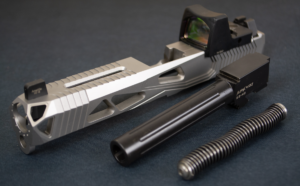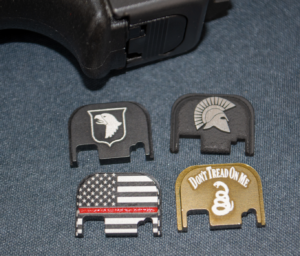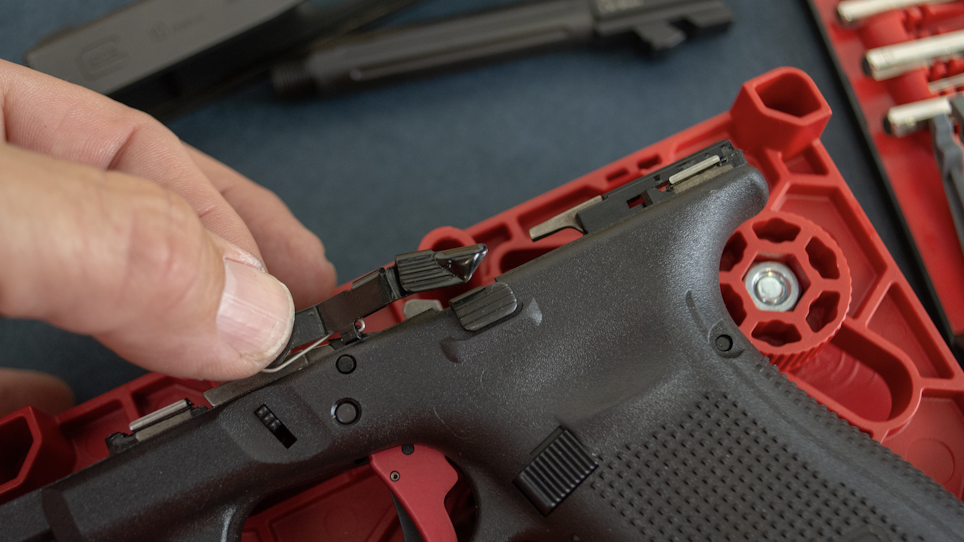Only Gaston knows for sure, but there are millions of Glock pistols in circulation. The real number is nearly impossible to find without breaking into the big man’s file cabinet, but consider this: as of 2015, reports show Glock pistols coming out of U.S. production facilities at the approximate rate of 250,000 per year.
That number gets blurry because only frames, slides and barrels are made in the United States. Everything else is manufactured in Austria, as are more frames, barrels and slides. As a result, some Glocks are assembled in the United States while others are produced in Austria and imported. The net-net of all this math is that hundreds of thousands of Glocks enter the market every year.
As a retailer, you can certainly make a few bucks by selling your share of these, but given the competitive nature of the product, margins are slim, and there are not many unique value-add opportunities other than price. On the other hand, many of your potential customers already own Glocks and are ripe for component upgrades and customization.
One of the side benefits of the pervasive nature of the Glock pistol is the vast array of aftermarket opportunities for functional, performance and even cosmetic upgrades.
Upgrades are compelling sales opportunities for a couple of reasons. The number of existing pistols in your market dwarfs that of annual new pistol sales, so there’s a significant and largely untapped market. The other benefit is the service and differentiation component to the sale. While some customers have no fear of taking apart their pistol to install a new trigger group or firing pin, others are more than happy to pay you a fair wage to do it on their behalf.
Let’s take a look at some easy upgrade opportunities. We’ve chosen these because of their straightforward nature. If you have a gunsmith on staff, great. If you don’t, no worries. All of these upgrades can be done with a few basic and affordable tools and just a bit of know-how. The best part? You can not only sell the parts but charge for the installation. The secret to success is knowing what’s available and being able to effectively communicate the vision to your customers.

Swapping barrels and slides can add some flair to a Glock and give customers something new to consider. (Photo: Tom McHale)
Barrels
Glock barrels are pretty darn good right out of the box, so why would anyone want to spend their hard-earned dollars to replace what they already have? There are four good reasons; let’s consider each.
Swap calibers
Glocks haven’t exactly made their reputation by offering radically different models over the years. In fact, many of them are virtually indistinguishable from one another. The fact that a Glock 17 looks exactly like a Glock 22 offers you an opportunity. As just one example, changes in caliber agency preferences are resulting in a glut of Glock 22 .40 S&W pistols.
Have a customer with one of those .40 S&W pistols who would prefer a 9mm? No problem — and no need to swap guns. Just offer your customer a conversion barrel such as the Glock 22/32 to 9mm model. The Lone Wolf example carries an MSRP of $99.95 and provides a “no gunsmithing” installation. You’ll want to swap out the recoil spring and magazines for reliable function, but those are also field stripping only changes.
Silence!
So the Hearing Protection Act still hasn’t passed, but suppressors are still a compelling upgrade, even with the onerous $200 tax stamp requirement. Few pistols come with threaded barrels, so that presents an easy upgrade opportunity. As a drop-in and out operation, it’s entirely feasible to offer customers a “suppressor” option for their existing everyday gun. Drop in the extra threaded barrel for range outings and switch back to the standard for concealed carry, duty or home defense use.
Get the Lead Out
We’ll stay out of the controversy over whether shooting lead bullets from a Glock barrel will cause imminent global disaster. The fact is that the polygonal rifling of Glocks isn’t as lead friendly as traditional cut rifling patterns, so the practice is generally frowned upon. No worries, most replacement barrel manufacturers such as Apex and Lone Wolf offer products that are just fine to use with lead bullets.

Personalized accessories can accent a Glock and give the owner more of a connection with it. (Photo: Tom McHale)
Make It Personal
On a stock pistol, a jazzed-up barrel with cosmetic cuts and finish doesn’t make a whole lot of sense because you can’t see it. However, when combined with a slide upgrade, it can be a sexy addition. With a stock slide, this barrel upgrade doesn’t make as much sense. However, when you combine it with a custom cut slide, a fluted barrel becomes much more compelling.
Performance Upgrades
Part of the benefit of Glock’s standardization over the years is that many parts and components are compatible across models and even generations. That makes it easier for you to stock and install pieces and parts like takedown levers, extended slide releases, firing pins and more.
Titanium Firing Pin
Here’s a performance upgrade with safety and accuracy benefits. An ultra-light firing pin reduces striker weight by more than 60 percent, offering the reduced likelihood of a drop discharge. The lower weight also reduces lock time by more than 30 percent so in theory there is less opportunity to come off target between the time you press the trigger and the bullet leaves the muzzle.
Installation is easy and requires nothing more than a pin to relieve pressure on the firing pin spring. Just press down (towards the muzzle) on the spring spacer sleeve so you can remove the slide cover plate. Once that’s out, the striker and spring replacement is a drop-in swap.
Slide Cover Plates
While you’re replacing the firing pin, how about personalizing the slide cover plate? Dozens of colored and engraved options are available, and it’s a low-risk way to personalize a pistol. As with the firing pin upgrade, installation requires nothing more than a punch or pin to relieve spring pressure while you slide the old one out and the new one in.
Extended Slide Stop/Release
An easy and dramatic performance upgrade opportunity is to swap the standard slide release/lock lever with an enlarged one. The factory part is subtle and recessed. That can make a quick slide release a bit uncertain, and therefore slow. As with other simple upgrades, this one requires nothing more than a Glock Armorer’s tool (pin punch). Investing in a couple of tools like the Real Avid Accu-Punch set and Apex Tactical Armorer Block will make this job easier.
Trigger Upgrades
A good trigger does nothing to change the mechanical accuracy of a pistol, but it goes a long way toward making one easier to shoot well. Once you get the hang of how a Glock pistol functions by taking an armorer’s class, upgrading components such as the trigger system become straightforward operations.
The standard Glock has a definite “service” feel by design along with a 5.5-pound pull weight. Whether your customer wants a lighter and smoother trigger for competition or just an improved one with adequate weight for defensive use, there are a lot of options out there.
Three simple components can be mixed and matched to provide the precise trigger weight and action your customer wants. A new trigger face can offer adjustable pre- and over-travel along with an improved feel and cosmetic improvement. Swapping out the connector bar can adjust the pull weight up or down from the standard 5.5 pounds while improving the feel. The trigger spring can also impact pull weight by providing more or less assistance to the trigger press motion. The best part is that few people know what a good trigger can do, what makes that tick and how to do the modifications. That spells add-on parts and service sales opportunities.
So, what do you get from a trigger component upgrade? One of my Glock 19 Gen IV pistols averaged a 5.75-pound trigger weight. Before the break, I could feel about 3/8 inch of gritty take-up. At that point, I hit a shelf of higher pressure followed by 1/4 inch additional travel before the break. The reset occurred after 1/4 inch of let-off. After installing the trigger upgrade (a service weight connector) the press was right near 4 pounds, the grit was gone and overall travel shrank to 3/16 inch. The trigger resets with just 1/8 inch forward travel. Quite an improvement. Consider equipping a demo pistol in your store with such an upgrade so customers can feel the difference.
Whether you love Glocks or hate them, their pervasiveness and reliability as a platform have created a seemingly boundless market for aftermarket parts and upgrades. Whatever the component, someone out there has designed an alternative that performs the desired function differently and sometimes better.
Maybe it’s a good time to start having some conversations with all the Glock owners who frequent your business about some of the things they can do with their “plain ol’ pistol.”






